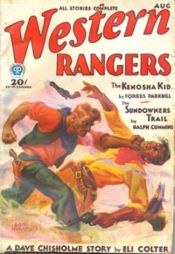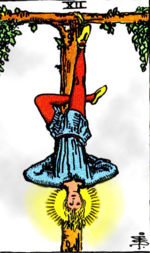ATD 171-198
- Please keep these annotations SPOILER-FREE by not revealing information from later pages in the novel.
Contents
Page 171
Kieselguhr KidDynamite, a blasting explosive, was invented in 1867 by Alfred P. Nobel by mixing nitroglycerin with kieselguhr.
The name also recalls the Kenosha Kid sequence of Gravity's Rainbow, which may have taken its name from a 1931 pulp fiction story by Forbes Parkhill, a two-fisted wild west adventure.
...detective agencies like Pinkerton‘s and Thiel‘s
see Wikipedia Entries 1,2
Sangre de Cristos
southernmost subrange of the Rocky Mountains. Wikipedia Entry
Page 172
Butch Cassidy
infamous outlaw Wikipedia Entry
Lombroso, Dr. Cesare (1835-1909)
Born in Verona, Italy, Dr. Lombroso, using concepts drawn from Physiognomy, early Eugenics, Psychiatry and Social Darwinism, devised the theory that criminality was inherited, and that the born criminal could be identified by physical defects, which confirmed a criminal as savage, or atavistic; Wikipedia entry
Lodazal
spanish for bog, quagmire (?)
Page 173
"got us a man of principle"
Eerily reminiscent of Theodore Kaczynski, aka the Unabomber, the convicted American murderer known for his campaign of mail bombings, many of which were addressed to specific victims, intended by Kaczynski to draw attention to what he percieved as the ills of technology on modern society. Wikipedia entry.
There a several tenuous threads of connection between Pynchon and the Unabomber. Pynchon has written works exploring the dangers of modern technology and, more specifically, ludditism. [1] [2] As a young man, Pynchon co-wrote such a play, Minstral Island, with his Cornell classmate Kirkpatrick Sale, who later would become one of the world's most prominent and outspoken luddites. Sale later said, "The Unabomber and I share a great many views about the pernicious effect of the Industrial Revolution, the evils of modern technologies, the stifling effect of mass society, the vast extent of suffering in a machine-dominated world and the inevitability of social and environmental catastrophe if the industrial system goes unchecked," although naturally Sale condemned the Unabomber's method. When the Unabomber's identity was still unknown, Pynchon was suggested (with who knows what degree of seriousness, and by whom) as a possible suspect. [3]
"jizzmatic juices backin' up, putting pressure on the brain" 'Jizzmatic juices' seems to be a Pynchon-created slang phrase for semen, adapted from the dictionary-found slang word for semen, "jism". Pynchon has "a lady acquaintence" of Mr. Ponghill as responsible for the "naive theory" [Lew Basnight], commonly-enough held, that lack of sex --"lack of exposure to the fair sex", previous paragraph--can affect the brain and therefore one's judgment.
"Don't mean he ain't got a right to his privacy."
Continues the Unabomber/Pynchon connection. Pynchon follows the description of a dynamite bomber with the right to privacy, something that Pynchon has guarded closely his entire life. For more on Pynchon and privacy, see page 37.
Page 174
"your own brother"
The Unabomber was turned in by his brother. ("Kaczynski" means 'ducky' or 'duckman'. Did TRP hide this somewhere?)
Page 176
Tortoni's on Arapahoe
Italian restaurant located in the 1500 block of Arapahoe Street in downtown Denver. Photo
Gahan's saloon across the street from City Hall
Saloon operated by William Gahan, a Denver City Councilman, and his brothers conveniently located at 1401 Larimer Street in Denver, across the street from City Hall. Gahan operated two other saloons, including one at 1133 Larimer Street, which he supposedly kept open on Sundays, harbored gambling, and sponsored a boys' baseball team that played for beer.
Ed Chase, the boss of the red-light district
Edward "Big Ed" Chase (1838-1921) was a New Yorker from Saratoga Springs who became the leader of criminal activities in Denver from 1860 on, and as such was an influential and respected man. He ran saloons, gambling houses, bordellos, and theaters (specializing in "burlesque"), and served on the Denver City Council from 1866-1869. After that, he was a behind-the-scenes ward boss and power broker for the Republican party, which dominated Denver politics at the time. Nearly every 19th century election in Denver was clouded by charges that Chase had organized an army of voters out of riffraff, vagrants, prostitutes, barflies and gamblers. By the time of his death in 1921, Chase had come to be regarded as a respected real estate investor and capitalist. For more info, consult The City & The Saloon: Denver 1858-1918 by Thomas J. Noel.
Page 177
The Row
Denver‘s red light district developed along McGaa Street (subsequently renamed Holladay and then Market Street) 1 2
Page 178
W.F.M.
Western Federation of Miners Wikipedia Entry
Page 179
different tempos and keys
Cf 'anarchist miracle' in "Lot 49" (chapter 5).
Page 180
Valley Tan
Mormon whiskey reported by Mark Twain. cite
Page 182
P.E.T.N.
Ingredient of Semtex, discovered 1891. Wikipedia
Page 184
Kankakee
city in Illinois.
things would happen gradually enough to afford time to do something about it
A central idea in Gravity's Rainbow, which features a rocket that breaks the sound barrier and thus the ability to kill you before you hear it coming.
Page 185
excursion
Wilde's US lecture tour was in 1882.
Page 186
grifaMarijuana. cite
Miss Colman-Smith is West Indian [tarot cards]
Pamela Colman Smith (1878—1951) was an artist, illustrator, and writer. She is best known for designing the Rider-Waite-Smith deck of tarot cards for Arthur Edward Waite. Smith was born in England, the daughter of an American merchant from Brooklyn, Charles Edward Smith and his Jamaican wife Corinne Colman. Due to her father’s job with the West India Improvement Company, the family often moved, spending time in London, Kingston, Jamaica and Brooklyn, New York. Wikipedia entry
Pynchon's interest in the tarot is evident in Gravity's Rainbow. Two tarot cards are referred to here -- the Hanged Man (image) and the Knight of Swords (image). The reference is an anachronism, as the deck wasn't published until 1909.
Perseid
August (1900).
Page 187
hell of a blow-up . . . . maiden's sigh
Possible allusion to the testing of Trinity Bomb, the first explosion of an atomic weapon, which took place at White Sands, New Mexico on July 16, 1945. Wikipedia.
Page 188
Galveston Hurricane
An historical event (8th September 1900, 6000 dead).
[Wikipedia]
Page 192
nearly twenty
1883 + 19yo = 1902?
Page 193
Uncompahgre
A Plateau in Western Colorado, named after the Uncompahgre Ute Indian Tribe. [Wikipedia]
three-dollar sack suit That is, a suit one might buy at a store where one fills a sack with clothes and then pays three dollars for the lot. A sack suit is an ordinary 19th-c. business suit which "evolved into the modern three piece suit." [4]
Page 194
Dallas Divide
Mountain Pass dividing the Uncompahgre Plateau from the San Juan Mountains. [Wikipedia]
Page 195
Sloat Fresno
Possibly named for Commodore John D. Sloat, American naval officer who claimed California, then a territory of Mexico, as part of the United States on July 7, 1846. The text of the declaration can be found [here]. Another source may be the Sloat Lumber Co. of Quincy, CA, which used an uncommon 30 gauge track, about which all I can find is [here]. Fresno is presumably a reference to the [city in California], though its direct relation to either the Commodore or the Sloat Lumber Co. is unclear. [Wikipedia Site on John D. Sloat]
Sloat is another term for slat, a narrow piece of wood. Fresno is Spanish for ash.
copping the borax
? Seemingly a term invented by Pynchon. No idea what it means, but borax is a mineral used in detergent, pottery, a lots of other things. Wikipedia on Borax
Montrose Montrose, CO. [Wikipedia]
Page 197
coupling pin
pic
Page 198
The Light Over the Ranges
Repeats the title of Part One and also suggests Tesla's 03 July 1899 'vision'. (The singular 'range' seems called for-- so why plural here?)
Jeshimon
Literally: "the waste", more specifically the wilderness of Judah in the Bible, near the Dead Sea. christiananswers.net. In the context of the following events, a contrast to the meaning of WASTE in "Lot 49"?
Annotation Index
| Part One: The Light Over the Ranges |
|
|---|---|
| Part Two: Iceland Spar |
119-148, 149-170, 171-198, 199-218, 219-242, 243-272, 273-295, 296-317, 318-335, 336-357, 358-373, 374-396, 397-428 |
| Part Three: Bilocations |
429-459, 460-488, 489-524, 525-556, 557-587, 588-614, 615-643, 644-677, 678-694 |
| Part Four: Against the Day |
695-723, 724-747, 748-767, 768-791, 792-820, 821-848, 849-863, 864-891, 892-918, 919-945, 946-975, 976-999, 1000-1017, 1018-1039, 1040-1062 |
| Part Five: Rue du Départ |

